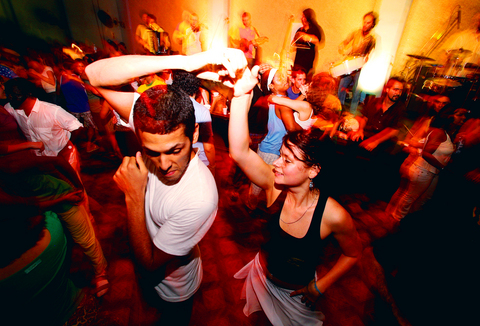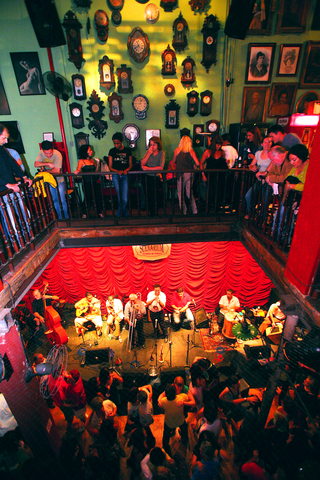In the whitewashed bohemian outpost of Santa Teresa, far from the Rio de Janeiro of tourist mythology, the beach hedonism of Zona Sul neighborhoods like Ipanema and Copacabana seems almost irrelevant. Here, local artists have claimed 19th-century hilltop villas that are sandwiched between squatter slums and offer stunning views of the coast.
At lunch in unpretentious Bar do Mineiro, a grizzled artist offered advice on how to spend an evening out in Rio. "There is no soul in the Zona Sul," he said. "If you are going out, you must only go to Lapa."
He was talking about Santa Teresa's neighbor, which shares the same historic architecture and still-dubious reputation as Santa Teresa. The two are linked by the bonde, a precarious but unforgettable tram that passes over Lapa's aqueduct, and by the stairs connecting the Convento de Santa Teresa to Rua Joaquim Silva in Lapa.

PHOTOS: NY TIMES NEWS SERVICE
Lapa offers an alternative to the slick, soulless clubs of the Zona Sul (or South Zone), whose anxiousness to convey international-style exclusivity cannot allay the nagging feeling that Rio's real action lies elsewhere. Revitalization has begun to take place farther afield, in places like Lapa, the scene of a rebirth of samba, where spontaneity and history commingle.
"The moment we're living in will be remembered as a historical one in the history of Rio samba, and a great part of that is because of Lapa," the samba musician and singer Nilze Carvalho, 37, told me.
The exodus of middle-class nightlife — even concerts and bars — to glittering shopping malls in Rio probably reflects security concerns as much as it does creeping Americanization. But for the traveler, this isn't just boring, it's depressing.

Luckily, not all Cariocas, as residents of Rio are called, are into fortress socializing. Considering the options, Cristiano Nogueira, the 31-year-old author of the guidebook Rio for Partiers, said: "I want the fear. I want the drama. I want the sweat."
Lapa offers all three in spades.
Getting to Lapa — 20 minutes and a 25-reais cab ride (about US$12) from the Zona Sul — can seem like a trek, but if it were any closer to shore, it would doubtless be spoiled, as Copacabana has long been, beset by overexposure, seediness and Disney-like garishness. As it is, Lapa's charm exists in the gentle mildewing of its colonial-era architecture, in its sense of unfolding transformation.
At the neighborhood's heart is the Arcos da Lapa aqueduct, which, despite having been built in 1723 by slaves, is curiously modernist in its starkness. At night, it is surrounded by blithe, raucous activity. On one side of the aqueduct, fans line up for the sweeping tents of Circo Voador, a semi-outdoor music club; on the other, the square is jammed with revelers and vendors selling bottles of Skol beer. Cobblestones and sidewalks receive the scuttle and strut of impromptu samba. Gaggles of musicians swing cavaquinhos, the diminutive guitars that give samba music its characteristic tink, sidling up to drinkers slumped in plastic chairs in the street.
In the early decades of the 20th century, Lapa was a rowdy neighborhood of ill repute, of the best sort. Known as the Montmartre of South America, its streets were studded with cabarets, brothels and casinos, until the dictator Getulio Vargas put his foot down in the 1940s.
That era lives on in two narratives: that of the malandro, the shiftless but debonair seducer immortalized in a pop opera by a Rio native son, Chico Buarque, and the tempestuous black bisexual drag queen Madame Sata, subject of an eponymous 2002 movie. (The gender-bending legacy is now carried by the transvestites lining Lapa's streets, their outfits only a few degrees skimpier than the average nonprofessional Carioca.) In Madame Sata, Lapa is more than a backdrop — it is a character in a drama of marginality, the apotheosis of feverish creativity and full-throttle pageantry.
Before rebirth came decay. The new cult of beachgoing moved Rio's center of action to the shore, and in 1960, when Rio lost its crown as the nation's capital to Brasilia, deterioration in Lapa and the surrounding area accelerated. Marco Araujo, 40, the manager of the pioneering samba house Carioca da Gema, put it bluntly: "Lapa was dead, but musicians from Rio still remembered it as their symbol of samba."
Later, samba, commonly recognized as the Brazilian national art, also fell out of vogue, said Araujo. "Young people preferred to go to clubs and discos," he said. "But when they came here to Lapa, they rediscovered the samba that was their childhood."
He compared it to the resurgent popularity of cachaca, the potent sugar cane liquor that provides the national cocktail, the caipirinha, with its kick. "Cachaca and samba walk together on the same road," he said.
The past five years have brought increased gentrification, but Lapa's grungier corners and poor lighting initially gave some pause. "At first, when we opened this place, people were scared to come," said Elma Cola, an owner of Rio Scenarium, one of the most successful samba houses to shake up the neighborhood. It only takes one look down the atrium balcony, with its three-floor view of revelers of all ages, to see that people have changed their minds.
Lively yet genteel, this sprawling spot is as accessible to older couples watching the performances from tables as it is to bright young things alternating between samba and international-pop dance floors.
The slightly overproduced, museum-meets-boudoir decor is no accident; by day, antiques stores and an outdoor fair help drive Lapa's recovery.
"The crime isn't so bad in Lapa," said the Brazilian director Domingos de Oliveira, 69. He was about to take to one of the Rio Scenarium stages, once home to a cabaret in Lapa's first heyday, to preside over his own samba-infused cabaret. "The drug traffickers have sympathy for the place," he said, chuckling.
A neighborhood improvement association dominated by business owners like Plinio Froes, another Rio Scenarium owner, has been named Novo Rio Antigo (New Antique Rio), a nod to history. Nelson Porto, a 27-year-old designer who cofounded the Web site www.lanalapa.com.br, which focuses on Lapa's night life and cultural offerings, pointed out that Lapa was one of the few neighborhoods in Rio where the original pre-20th-century architecture survives. He cringed at the mention of the modernist towers of the Zona Sul, testaments to a midcentury building boom that now seems dated and tacky.
Many musicians who have enjoyed a sudden growth in audience and venues appreciate the difference. Carvalho said, "Playing the songs written by the old composers alongside our own songs, in the buildings with the original architecture, even people who don't know samba can feel the connection."
"This is where the emotions are happening," Porto said. "People work or live there, and they come here to have fun."
That kind of natural joy is on display at Clube dos Democraticos, an old ballroom with fading touches of grandeur and a spirit that is very much flourishing.
Its Wednesday night forro party is doubtless one of Lapa's most popular events. The rustic accordion-driven genre originating in Brazil's northeast may seem a tad folksy for a city hooked on glamour, but the Cariocas transforming the classy dance hall into a sweaty pit seize on its sensuality.
Languid and tanned, they begin dancing even while waiting in line, shimmying up the grand staircase, and clasping each other the moment they step onto the tiled floor.
"It can scare the upper class that Lapa is a totally democratic place that brings together a mix of classes," said Porto.
Froes cited a study commissioned by Novo Rio Antigo that found a tremendous socioeconomic diversity in Lapa's nighttime population. Upscale institutions like the air-conditioned, loft-like Estrela da Lapa may charge a cover that ensures a more moneyed crowd, but Lapa's energy crackles in the streets as much as within walls.
There are the spontaneous street parties near the Arcos, the crush of bodies hypnotized by the music. There are the circles of listeners from all walks of life, gustily singing along with every word, so engrossed that they barely notice the still rare but increasing presence of foreigners. Self-consciousness is irrelevant. In this moment, these streets welcome all.
On the Net: www.barcariocadagema.com.br; www.rioscenarium.com.br, www.estreladalapa.com.br; www.centroculturalcarioca.com.br

The canonical shot of an East Asian city is a night skyline studded with towering apartment and office buildings, bright with neon and plastic signage, a landscape of energy and modernity. Another classic image is the same city seen from above, in which identical apartment towers march across the city, spilling out over nearby geography, like stylized soldiers colonizing new territory in a board game. Densely populated dynamic conurbations of money, technological innovation and convenience, it is hard to see the cities of East Asia as what they truly are: necropolises. Why is this? The East Asian development model, with

June 16 to June 22 The following flyer appeared on the streets of Hsinchu on June 12, 1895: “Taipei has already fallen to the Japanese barbarians, who have brought great misery to our land and people. We heard that the Japanese occupiers will tax our gardens, our houses, our bodies, and even our chickens, dogs, cows and pigs. They wear their hair wild, carve their teeth, tattoo their foreheads, wear strange clothes and speak a strange language. How can we be ruled by such people?” Posted by civilian militia leader Wu Tang-hsing (吳湯興), it was a call to arms to retake

This is a deeply unsettling period in Taiwan. Uncertainties are everywhere while everyone waits for a small army of other shoes to drop on nearly every front. During challenging times, interesting political changes can happen, yet all three major political parties are beset with scandals, strife and self-inflicted wounds. As the ruling party, the Democratic Progressive Party (DPP) is held accountable for not only the challenges to the party, but also the nation. Taiwan is geopolitically and economically under threat. Domestically, the administration is under siege by the opposition-controlled legislature and growing discontent with what opponents characterize as arrogant, autocratic

When Lisa, 20, laces into her ultra-high heels for her shift at a strip club in Ukraine’s Kharkiv, she knows that aside from dancing, she will have to comfort traumatized soldiers. Since Russia’s 2022 invasion, exhausted troops are the main clientele of the Flash Dancers club in the center of the northeastern city, just 20 kilometers from Russian forces. For some customers, it provides an “escape” from the war, said Valerya Zavatska — a 25-year-old law graduate who runs the club with her mother, an ex-dancer. But many are not there just for the show. They “want to talk about what hurts,” she